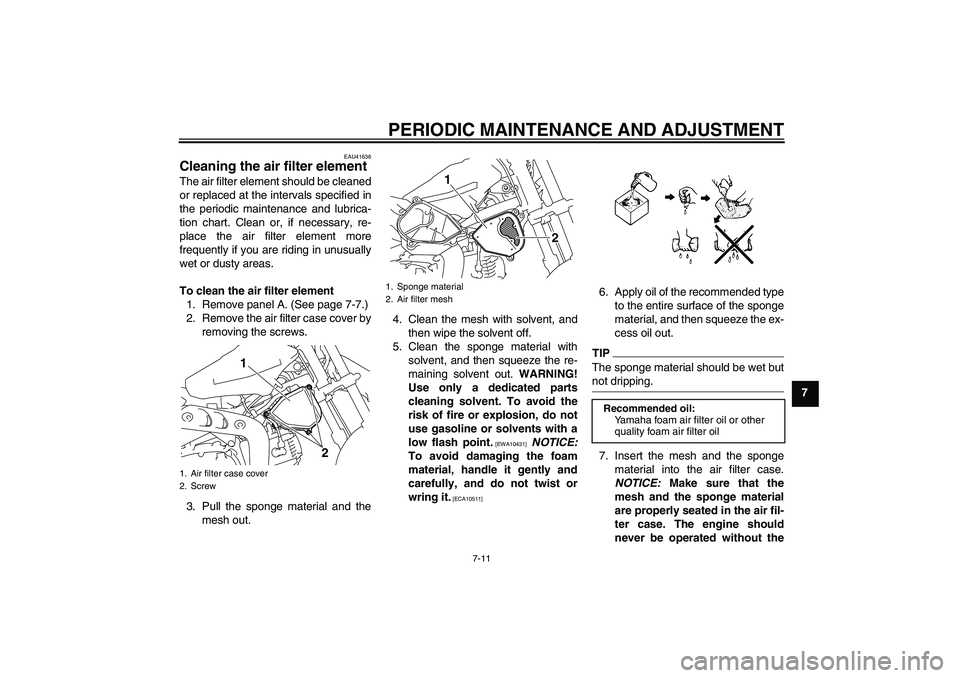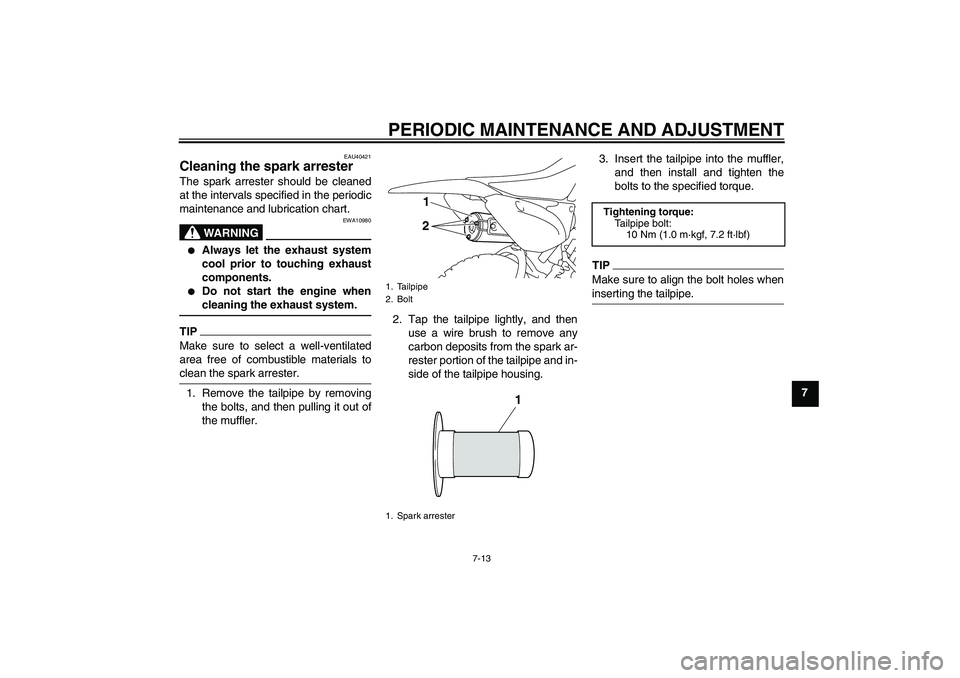Page 49 of 84

PERIODIC MAINTENANCE AND ADJUSTMENT
7-9
7 2. Check the spark plug for electrode
erosion and excessive carbon or
other deposits, and replace it if
necessary.
3. Measure the spark plug gap with a
wire thickness gauge and, if nec-
essary, adjust the gap to specifica-
tion.To install the spark plug
1. Clean the surface of the spark plug
gasket and its mating surface, and
then wipe off any grime from the
spark plug threads.
2. Install the spark plug with the
spark plug wrench, and then tight-
en it to the specified torque.
TIPIf a torque wrench is not available when
installing a spark plug, a good estimate
of the correct torque is 1/4–1/2 turn
past finger tight. However, the spark
plug should be tightened to the speci-
fied torque as soon as possible.3. Install the spark plug cap.
EAU39844
Engine oil The engine oil level should be checked
before each ride. In addition, the oil
must be changed at the intervals spec-
ified in the periodic maintenance and
lubrication chart.
To check the engine oil level
1. Place the motorcycle on a level
surface and hold it in an upright po-
sition. A slight tilt to the side can re-
sult in a false reading.
2. Start the engine, warm it up for
several minutes, and then turn it
off.
3. Wait a few minutes until the oil set-
tles, remove the oil filler cap, wipe
the dipstick clean, insert it back
into the oil filler hole (without
screwing it in), and then remove it
again to check the oil level.TIPThe engine oil should be between the
tip of the dipstick and the maximum lev-
el mark.
Specified spark plug:
NGK/CR6HSA1. Spark plug gapSpark plug gap:
0.6–0.7 mm (0.024–0.028 in)
Tightening torque:
Spark plug:
12.5 Nm (1.25 m·kgf, 9.0 ft·lbf)
U5B682E0.book Page 9 Tuesday, June 9, 2009 2:04 PM
Page 50 of 84

PERIODIC MAINTENANCE AND ADJUSTMENT
7-10
74. If the engine oil is not between the
tip of the dipstick and the maxi-
mum level mark, add sufficient oil
of the recommended type to raise
it to the correct level.
5. Insert the dipstick into the oil filler
hole, and then tighten the oil filler
cap.
To change the engine oil
1. Start the engine, warm it up for
several minutes, and then turn it
off.
2. Place an oil pan under the engine
to collect the used oil.3. Remove the engine oil filler cap,
the drain bolt and the gasket to
drain the oil from the crankcase.
4. Install a new gasket and the en-
gine oil drain bolt, and then tighten
the bolt to the specified torque.
5. Refill with the specified amount of
the recommended engine oil, and
then install and tighten the engine
oil filler cap.
NOTICE
ECA11620
�
In order to prevent clutch slip-
page (since the engine oil also
lubricates the clutch), do not
mix any chemical additives. Do
not use oils with a diesel speci-
fication of “CD” or oils of a high-
er quality than specified. In
addition, do not use oils labeled
“ENERGY CONSERVING II” or
higher.
�
Make sure that no foreign mate-
rial enters the crankcase.
6. Start the engine, and then let it idle
for several minutes while checking
it for oil leakage. If oil is leaking, im-
mediately turn the engine off and
check for the cause.
7. Turn the engine off, and then
check the oil level and correct it if
necessary.
1. Engine oil filler cap
2. Engine oil dipstick
3. Maximum level mark
4. Tip of the engine oil dipstick
1
3
4
2
1. Engine oil drain bolt
2. GasketTightening torque:
Engine oil drain bolt:
20 Nm (2.0 m·kgf, 14 ft·lbf)
1
1
2
Recommended engine oil:
See page 9-1.
Oil change quantity:
0.80 L (0.85 US qt, 0.70 Imp.qt)
U5B682E0.book Page 10 Tuesday, June 9, 2009 2:04 PM
Page 51 of 84

PERIODIC MAINTENANCE AND ADJUSTMENT
7-11
7
EAU41636
Cleaning the air filter element The air filter element should be cleaned
or replaced at the intervals specified in
the periodic maintenance and lubrica-
tion chart. Clean or, if necessary, re-
place the air filter element more
frequently if you are riding in unusually
wet or dusty areas.
To clean the air filter element
1. Remove panel A. (See page 7-7.)
2. Remove the air filter case cover by
removing the screws.
3. Pull the sponge material and the
mesh out.4. Clean the mesh with solvent, and
then wipe the solvent off.
5. Clean the sponge material with
solvent, and then squeeze the re-
maining solvent out. WARNING!
Use only a dedicated parts
cleaning solvent. To avoid the
risk of fire or explosion, do not
use gasoline or solvents with a
low flash point.
[EWA10431]
NOTICE:
To avoid damaging the foam
material, handle it gently and
carefully, and do not twist or
wring it.
[ECA10511]
6. Apply oil of the recommended type
to the entire surface of the sponge
material, and then squeeze the ex-
cess oil out.TIPThe sponge material should be wet but
not dripping.7. Insert the mesh and the sponge
material into the air filter case.
NOTICE: Make sure that the
mesh and the sponge material
are properly seated in the air fil-
ter case. The engine should
never be operated without the
1. Air filter case cover
2. Screw
2 1
1. Sponge material
2. Air filter mesh
1
2
Recommended oil:
Yamaha foam air filter oil or other
quality foam air filter oil
U5B682E0.book Page 11 Tuesday, June 9, 2009 2:04 PM
Page 52 of 84
PERIODIC MAINTENANCE AND ADJUSTMENT
7-12
7mesh and the sponge material
installed, otherwise the pis-
ton(s) and/or cylinder(s) may
become excessively worn.
[ECA15572]
8. Install the air filter case cover by in-
stalling the screws.TIPMake sure that the spark plug lead is in-
serted into the guide as shown.
9. Install the panel.
To clean the air filter check hose1. Check the hoses at the bottom of
the air filter case for accumulated
dirt or water.2. If dirt or water is visible, remove
the hoses, clean them, and then
reinstall them.1. Spark plug lead
2. Guide
1. Air filter check hose
11
2
1
U5B682E0.book Page 12 Tuesday, June 9, 2009 2:04 PM
Page 53 of 84

PERIODIC MAINTENANCE AND ADJUSTMENT
7-13
7
EAU40421
Cleaning the spark arrester The spark arrester should be cleaned
at the intervals specified in the periodic
maintenance and lubrication chart.
WARNING
EWA10980
�
Always let the exhaust system
cool prior to touching exhaust
components.
�
Do not start the engine when
cleaning the exhaust system.
TIPMake sure to select a well-ventilated
area free of combustible materials to
clean the spark arrester.1. Remove the tailpipe by removing
the bolts, and then pulling it out of
the muffler.2. Tap the tailpipe lightly, and then
use a wire brush to remove any
carbon deposits from the spark ar-
rester portion of the tailpipe and in-
side of the tailpipe housing.3. Insert the tailpipe into the muffler,
and then install and tighten the
bolts to the specified torque.
TIPMake sure to align the bolt holes when
inserting the tailpipe.
1. Tailpipe
2. Bolt
1. Spark arrester
21
1
Tightening torque:
Tailpipe bolt:
10 Nm (1.0 m·kgf, 7.2 ft·lbf)
U5B682E0.book Page 13 Tuesday, June 9, 2009 2:04 PM
Page 54 of 84

PERIODIC MAINTENANCE AND ADJUSTMENT
7-14
7
EAU39930
Adjusting the carburetor The carburetor is an important part of
the engine and requires very sophisti-
cated adjustment. Therefore, most car-
buretor adjustments should be left to a
Yamaha dealer, who has the neces-
sary professional knowledge and expe-
rience. The adjustment described in the
following section, however, may be ser-
viced by the owner as part of routine
maintenance.NOTICE
ECA10550
The carburetor has been set and ex-
tensively tested at the Yamaha fac-
tory. Changing these settings
without sufficient technical knowl-
edge may result in poor perfor-
mance of or damage to the engine.
EAU21362
Adjusting the engine idling
speed The engine idling speed must be
checked and, if necessary, adjusted as
follows at the intervals specified in the
periodic maintenance and lubrication
chart.TIPA diagnostic tachometer is needed to
make this adjustment.1. Attach the tachometer to the spark
plug lead.
2. Start the engine and warm it up for
several minutes at 1000–2000
r/min while occasionally revving it
to 4000–5000 r/min.TIPThe engine is warm when it quickly re-
sponds to the throttle.3. Check the engine idling speed
and, if necessary, adjust it to spec-
ification by turning the throttle stop
screw. To increase the engine
idling speed, turn the screw in di-rection (a). To decrease the en-
gine idling speed, turn the screw in
direction (b).
TIPIf the specified idling speed cannot be
obtained as described above, have a
Yamaha dealer make the adjustment.1. Throttle stop screwEngine idling speed:
1600–1800 r/min
1(a) (b)
1
U5B682E0.book Page 14 Tuesday, June 9, 2009 2:04 PM
Page 55 of 84

PERIODIC MAINTENANCE AND ADJUSTMENT
7-15
7
EAU21382
Checking the throttle cable
free play The throttle cable free play should mea-
sure 4.0–6.0 mm (0.16–0.24 in) at the
throttle grip. Periodically check the
throttle cable free play and, if neces-
sary, have a Yamaha dealer adjust it.
EAU21401
Valve clearance The valve clearance changes with use,
resulting in improper air-fuel mixture
and/or engine noise. To prevent this
from occurring, the valve clearance
must be adjusted by a Yamaha dealer
at the intervals specified in the periodic
maintenance and lubrication chart.
EAU39822
Tires To maximize the performance, durabil-
ity, and safe operation of your motorcy-
cle, note the following points regarding
the specified tires.
Tire air pressure
The tire air pressure should be checked
and, if necessary, adjusted before each
ride.
WARNING
EWA15370
Operation of this vehicle with im-
proper tire pressure may cause se-
vere injury or death from loss of
control.
The tire air pressure must be
checked and adjusted on cold tires
(i.e., when the temperature of the
tires equals the ambient tempera-
ture).
1. Throttle cable free play
1
Standard tire air pressure:
Front:
100 kPa (1.00 kgf/cm², 15 psi)
Rear:
100 kPa (1.00 kgf/cm², 15 psi)
U5B682E0.book Page 15 Tuesday, June 9, 2009 2:04 PM
Page 56 of 84

PERIODIC MAINTENANCE AND ADJUSTMENT
7-16
7Tire inspection
The tires must be checked before each
ride. If the center tread depth reaches
the specified limit, if the tire has a nail or
glass fragments in it, or if the sidewall is
cracked, have a Yamaha dealer re-
place the tire immediately.
Tire information
This motorcycle is equipped with spoke
wheels and tube tires.
WARNING
EWA10461
The front and rear tires should be of
the same make and design, other-
wise the handling characteristics of
the vehicle may be different, which
could lead to an accident.After extensive tests, only the tires list-
ed below have been approved for this
model by Yamaha Motor Co., Ltd.
WARNING
EWA14390
�
Have a Yamaha dealer replace
excessively worn tires. Operat-
ing the motorcycle with exces-
sively worn tires decreases
riding stability and can lead to
loss of control.
�
The replacement of all wheel-
and brake-related parts, includ-
ing the tires, should be left to a
Yamaha dealer, who has the
necessary professional knowl-
edge and experience.
�
It is not recommended to patch
a punctured tube. If unavoid-
able, however, patch the tube
very carefully and replace it as
soon as possible with a high-
quality product.
1. Tire sidewall
2. Tire tread depthMinimum tire tread depth (front and
rear):
4.0 mm (0.16 in)
12
Front tire:
Size:
2.50-14 4PR
Manufacturer/model:
CHEN SHIN/C-803-2
Rear tire:
Size:
3.00-12 4PR
Manufacturer/model:
CHEN SHIN/C-803-2
U5B682E0.book Page 16 Tuesday, June 9, 2009 2:04 PM